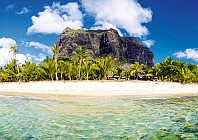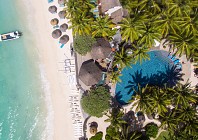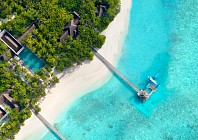|
The view outside the car window could not better encapsulate the term “island paradise”. It’s a cloudless day and the sun beams across water as clear as crystal, meeting pristine sand and lush forest beyond, where the mountain known as Lion’s Head is clearly visible. Suddenly, the weather turns and rain hits the car, blurring the perfect scene. My driver smiles. “Don’t worry, the rain won’t last long. The island is giving you a blessing and a warm welcome,” he says. |
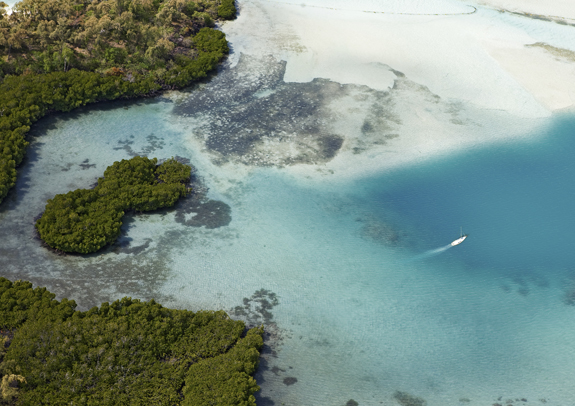
French Creole is the most widely spoken language in the island nation, though the culture and cuisine are heavily influenced by the island’s South African neighbours and the large Indian population. As this heady cultural cocktail suggests, Mauritius is far more than your standard island paradise — it bursts with the surprising and unexpected at every turn, and retains the characteristics of all those who have called it home. Here, adventures abound, whether you seek them or not.
CASTAWAY
As the car winds its way south-east to Blue Bay, a tiny natural reserve in the largely undeveloped part of the island, the heavens clear and we board a speedboat to our final stop: Le Touessrok resort, part of The Leading Hotels of the World. A 40-minute speedboat ride up the east coast takes us across that crystalline water, which seems to melt into the sky, to the resort’s dock next to a collection of ocean villas that pop out among the vegetation like sandcastles. ‘Touessrok’, the resort’s lovely guest relations officer Annabelle tells me, is a play on the French phrase “tu es roc” (you are rock), and it’s certainly evident that the focus at the resort is, well, you. The rooms, suites and villas are perched along the peaceful shores of Trou d’Eau Douce Bay, far from the hectic pace of the bustling capital, Port Louis — and, it seems, the rest of the world.
Despite the luxurious lodgings, I’m keen to get out and discover Le Touessrok’s other surprises. A 10-minute boat ride takes us to Îlot Mangénie, an uninhabited island reserved exclusively for Le Touessrok’s guests to come and unwind. Your castaway experience comes with some thoughtful additions, such as a sunglasses-cleaning service and cold towel upon arrival. There’s no need to cook your own catch here either — the chefs at the island’s restaurant, Crusoe’s, do all the hard work for you. Here, I get my first taste of Mauritian cuisine: fresh calamari and fish served with hot chilli paste and cool coconut relish, along with a salad of tender palm heart, nicknamed ‘Millionaire’s Salad’ as it is a Mauritian delicacy.
After a short siesta in the inviting winter sun, I reluctantly clamber back on the boat and over to Le Touessrok’s second island, Île aux Cerfs, where hammocks and sunloungers make way for waterskis and windsurfers. A short buggy ride further inland and you’ll discover Cerfs’ pride and joy: a championship golf course (voted one of the top 10 in the world) with fairways so soft you’ll want to play barefoot.
THE LIFE AQUATIC
The next morning, on the winding drive to Trou aux Biches, 10 minutes from the tourist hub of Grand Baie on the northern coast, the road takes us through villages whose names reflect the island’s mixed heritage: Camp Ithier, Bramsthan, Petite Retraite. Historic churches stand next to multicoloured confections of Hindu temples, pagodas and brilliant white mosques. “There used to be so many religious public holidays,” my driver quips, “that the government had to cut some to keep the economy going.”
Houses with corrugated iron roofs stand in the shadow of newer concrete homes, built to withstand cyclone season. Between the towns, plantations of sugarcane dotted with old sugar mill towers sprawl into the distance.
Despite the plethora of sights to take in above sea level, I’m keen to explore what’s happening below. Blue Safari at Trou aux Biches runs ocean tours in a 10-man submarine that wouldn’t look out of place in a James Bond film, and I eagerly hop aboard. At a depth of 35 metres, it appears that life below the surface is as colourful as life above.
Clownfish swim circles around blue tang while schools of rainbow runners hover in the water, seemingly suspended in animation. The reef itself stretches as far as the eye can see; a valley of undulating coral hills with sandy roads running between them. For those who prefer to be in charge of their own vehicle, you can opt to ride a subscooter to a depth of three metres. And if you’re pressed for time and need to sample as much of the underwater world as you can, there is also an option to eat lunch on board a smaller, five-person submarine, while it tours the seabed.
Back on the surface, it’s time to explore the island’s land beauty. A 15-minute drive south of Grand Baie, we arrive at Sir Seewoosagur Ramgoolam Botanical Garden in Pamplemousses, home to Mauritius’ famous giant water lilies, banyan trees and bottle palms, the national delicacy in its raw form. It takes seven years for each palm tree to grow to its full height before its fleshy heart can be extracted. As the palm tree cannot regenerate afterwards, the rule is that if you extract one, you must plant another in its place.
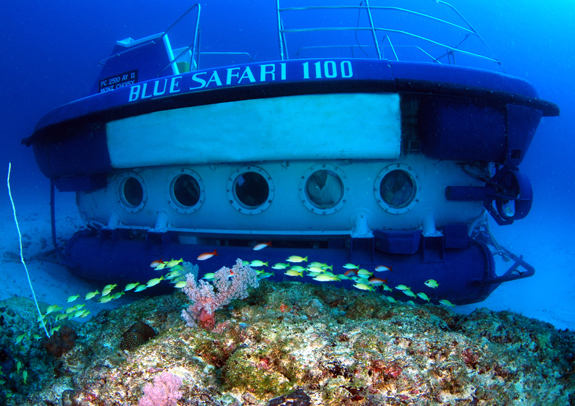
This sustainable attitude extends to sugarcane, too. Although no longer the island’s primary export (textiles and tourism share the load), no part of the sugarcane plant is wasted. The cane is used in vinegar, perfume and rum, while the remainder of the plant is used in furniture and as fertiliser.
All this exploring must be balanced with equal amounts of relaxation, so we head south to the coast, where Shanti Maurice awaits. The resort, another property from The Leading Hotels of the World stable, is nestled between mountains and sea, and from the moment I arrive, it’s clear that escapism is the aim of the game. Most suites and villas come with their own infinity pools and rain showers, and all open up onto the only section of Mauritian coastline unprotected by reef. With the sound of waves against rocks to lull you to sleep, it feels like it’s just you and the island.
INTO THE WILD
Driving northwest the next morning, we pass a mountain shaped like a gorilla’s head (dubbed ‘King Kong’), facing another mountain shaped like a sitting lion. The pair serves as an omen of what we’re about to face.
Mauritius is not renowned for its exotic fauna, but the island continues to surprise when we arrive at Casela Nature & Leisure Park, a 14-hectare sanctuary for exotic animals including flamingos, monkeys, zebra, giant tortoises and tigers. I’ve come to get up close and personal with the king of them all. The park’s ‘Walk with the Lions’ experience means I get to venture beyond the fence and straight into the home of the big cats. Stepping into the enclosure, it quickly becomes clear that the lions prefer sleeping in the sun than eating visitors, but the experience is both awe-inspiring and thrilling — one can’t fully tame a wild beast, after all.
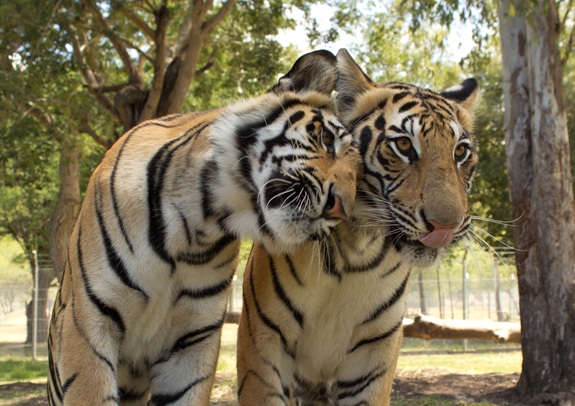
Back at Shanti Maurice, our final dinner of sweet lobster meat, sizzling prawns and squid accompanied by fresh salads and a side order of spirited traditional music and dancing is a spectacular way to round off the trip.
Walking back to my villa, I think about how lucky I’ve been to experience such a fascinating and genuine island culture — something that’s a little harder to unearth in other luxe island destinations like the Maldives. I stretch out by the pool and watch the moon cast light across the water until ominous clouds shadow it. Within minutes, a gentle sprinkling of rain begins — the tears of an island saying goodbye, and a blessing for our safe return.
THE GOLDEN BOOK
Le Touessrok
Tel: +230 402 7700
www.letouessrokresort.com
Tel:+230 603 7200
Constance Le Prince Maurice
Tel: +230 402 3636
princemaurice.constancehotels.com








